In the old days, bitters were used as a cure for many ailments. Today, they are more often treated with cocktails, to which “bitters” impart a huge range of tastes and aromas. We invite you to play in pharmacists and cocktail doctors, namely, to cook some real bitters at home.
Bitter (from German bitter, literally “bitter”) is a rather extensive group of strong alcoholic beverages, which usually includes some bitters, as well as vermouths and liqueurs. All bitters can be conditionally divided into two categories: actual bitters, as well as the so-called bitters. Drinks of the first category are concentrated bitters and are used mainly for flavoring cocktails, just a few drops (Angostura Bitters, Peychaud’s, Fee’s bitters, etc.). The second category of bitters are bitters, vermouths and liqueurs, which are “complete products”, that is, you can drink them in their pure form (Riga Balsam, Becherovka, Suze, Cynar, Campari, etc.).
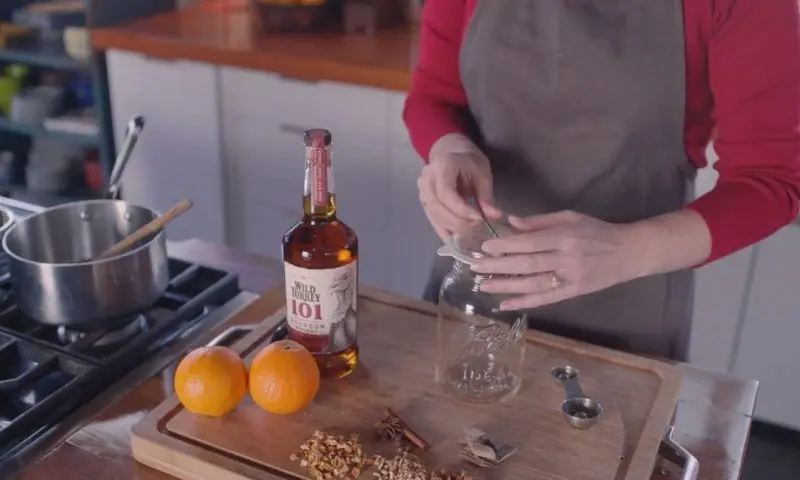
In this article, we will focus specifically on bitters, concentrated tinctures, since most of the “bitters” deserve separate articles (we have already prepared many of them, for example, Becherovka). At first glance, these are very complex drinks, whose place is exclusively in the commercial sector. But at home, bitters have been cooked for more than a century, and the process and recipes are described in dozens of cookbooks and manuals for bartenders. So let’s go!
Basic principles of making biterres
What plant ingredients to use for bitters?
Bitters are made up of bitter roots, bark or leaves, and other plant ingredients that provide flavor and aroma (as well as some medicinal properties). All ingredients for bitters can, again, be conditionally divided into bitter and flavor components. I immediately recommend using the herbal ingredients whole or slightly ground for easy filtration, but they can also be ground for faster maceration (in recent recipes, all ingredients are ground in a mortar, due to which soaking in alcohol is very fast).
Bitter components usually make up 10-50% of the mixture and may include various roots, bark and leaves. Most often these are: angelica root, barberry, echinacea, burdock, calamus, gentian, licorice, galangal (alpinia galanga), dandelion root and leaves, violet root, citrus peel, cinchona bark, cassia, wild cherry, artichoke and black walnut leaves , wormwood.
In the preparation of such drinks, measurements are very important, so it will be very difficult without accurate jewelry scales. For my alcohol experiments, I ordered inexpensive jewelry scales from AliExpress (link to these scales), which I wish you too. Haven’t regretted it in over a year.
Flavor components bitters round out and may include a variety of herbs, spices, flowers, fruits, nuts, and some legumes. This is exactly the part of the bitter that you can experiment with indefinitely and always get a product that is unlike anything else. Here are some of them:
- spice: cloves, cinnamon, cumin, anise, cardamom, black and allspice, coriander, fennel, star anise, ginger, vanilla, nutmeg, juniper, celery seeds;
- herbs and flowers: hibiscus, chamomile, sage, rosemary, rose, mint, lemongrass, lavender, hops, thyme, yarrow;
- fruit: fresh or dried citrus peel (lemon, lime, orange, grapefruit), dried fruits (cherry, apple, fig, raisin);
- Nuts: walnuts, almonds, hazelnuts;
- pulse: cocoa beans, coffee beans.
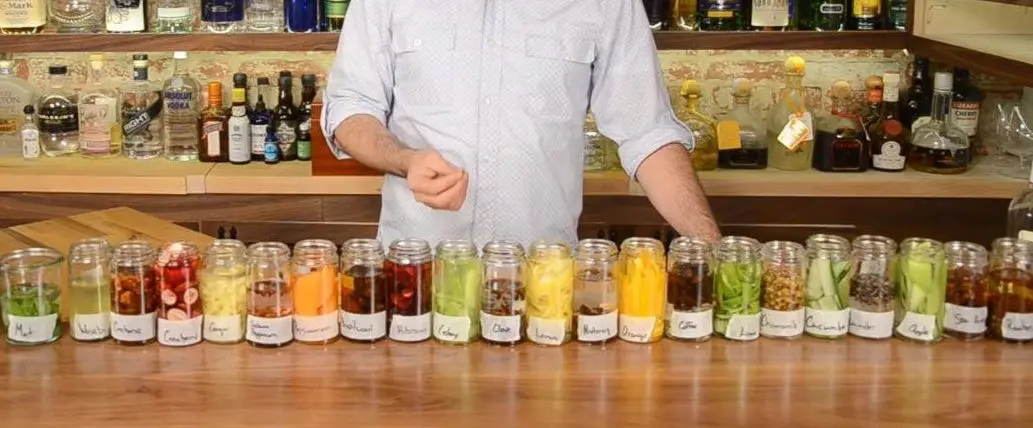
What is suitable as an alcohol base?
To obtain the maximum range of taste and aroma, it is recommended to use strong alcohol, more than 50%. Neutral taste will provide good grain alcohol in its pure form or diluted to 50-70%. In most cases, the official one may be enough, but then the time for insisting should be increased. Of course, no one forbids experimenting and taking more interesting drinks as a basis: bourbon or barrel-strength whiskey (from 50%), strong rum (for example, Stroh 50, 60 or 80), etc.
What else can you add to your bitter?
Bitter can also be sweetened (as you know, sugar reveals some flavors). To do this, you can use simple syrup, honey, molasses, caramel and other sweeteners. Most cocktails have sugar syrup and other sweet “agents” added to them, so most of the sweetener is completely unnecessary. Bitter can also be diluted with clean water up to 40-45%.
Which insistence method to use?
Of course, this is maceration, but here there are two fundamentally different ways. One way is to combine all the ingredients and steep them in an alcohol base together. Another way (it is used in several recipes below) involves the separate infusion of each individual ingredient (or group of ingredients), and then mixing the infusions to taste. I like the second way more, as it is much easier to control the result. Another thing is when you are confident in the recipe and then the method of preparing the bitter does not matter.
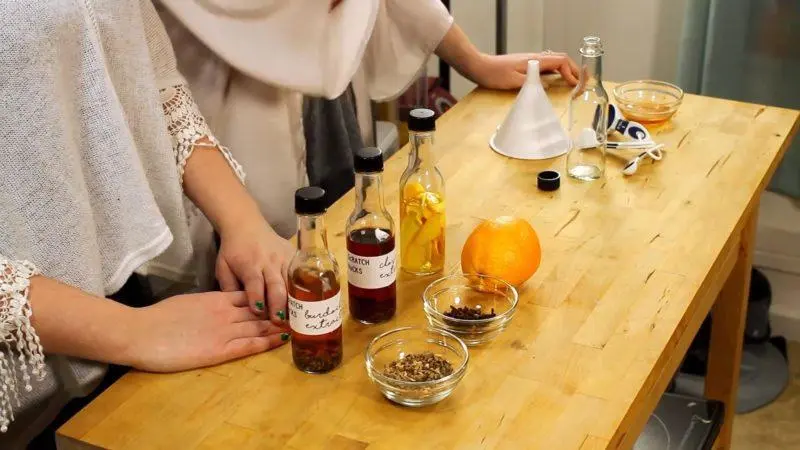
I recommend storing the so-called “botanical” ingredients in the form of extracts (in some recipes, they are indicated). Fresh herbs and roots are not stored for a long time, in dried form they lose their taste, aromatic and medicinal properties in about a year. In the form of extracts, they will last you much longer. To get an extract, make an alcohol-based tincture. The proportions depend on the type of raw material, 1:3 is optimal for the roots, that is, 1 part of the root to 3 parts of alcohol (in this case, 50% will be enough).
Roots can be microwaved before steeping to evaporate moisture (or dried naturally). Extraction takes 2-3 weeks. For most medicinal and aromatic herbs, it is better to use a ratio of 1:8. However, the proportions are very individual and the best result is achieved only experimentally.
How long to infuse bitters?
Depending on the ingredients, infusion can last from one day to several weeks. The duration also depends on the degree of grinding of the components – the powder has a much larger area of contact with alcohol than a whole branch or root. In any case, during the infusion process, it is recommended to carry out tests, both for smell and taste. To fully experience the smell of the infusion, rub a couple of drops of it on your palms and bring them to your nose. To test the taste, dilute a few drops of the infusion in a small amount of water.
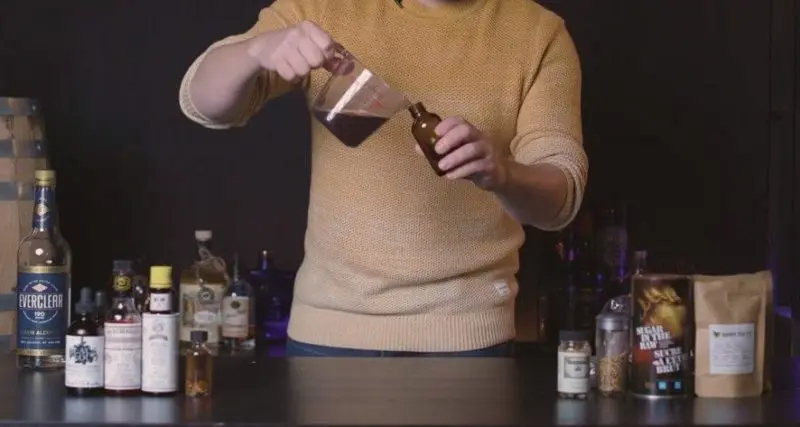
Where to store the finished bitter?
Long-term storage should be carried out only in glass. Sunlight over time affects the taste and color of any drink, so it is better to store bitters in dark glass containers (at worst, the glass can be painted over). Small dark glass bottles with a pipette remain ideal for this – in such a container the drink retains its taste and aroma for a long time, and the pipette allows you to accurately dose the bitter. Now such bottles can be bought in stores for electronic cigarettes (they are used for self-preparation of a mixture for vaping). But in retail, they are very expensive, so it is recommended to pay attention to Chinese wholesale (there are many such offers on AliExpress).
Homemade bitters recipes
There are a lot of recipes and bitters from the same category can vary greatly. Most often, orange bitter is prepared at home, because the recipes are very simple and most of the ingredients can be obtained at any supermarket. Below you will find two such recipes. Toward the end of the article, I decided to post more complex recipes, the ingredients for which you will have to look for in pharmacies or Western online stores (you can get anything, it’s only a matter of time and days).
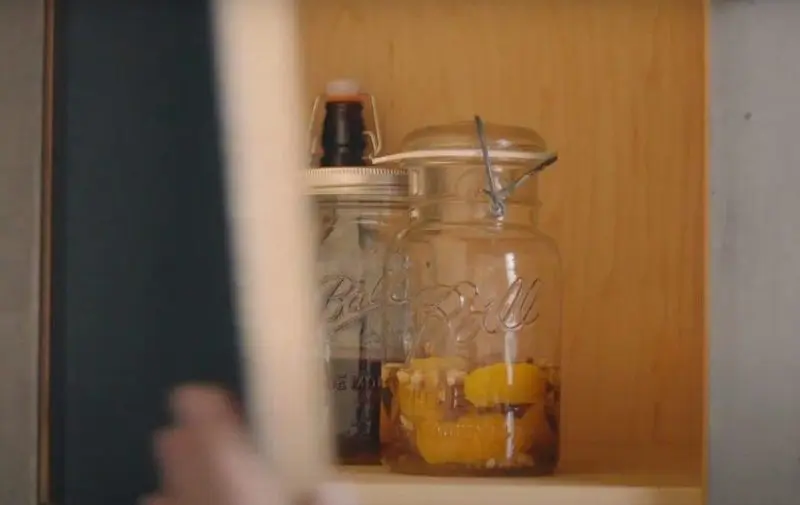
Bitter by Jerry Thomas (Decanter Bitter)
One of the first professionals who began to experiment with bitters was the legendary bartender Jerry Thomas. This recipe is taken from his 1862 bartender’s guide (The Bartender’s Guide: How To Mix Drinks, page 77). The author did not indicate the exact amount of rum, but in terms of meaning it is a whole bottle, which means that the resulting drink is not as saturated as other concentrated bitterness and you can try to drink it in its pure form. Only buy echinacea root from a trusted source, as some varieties can be poisonous.
- 100 г изюма
- 50 g cinnamon (bark or sticks)
- 30 g echinacea root
- 30 g clove buds
- 30 g allspice peas
- 1 large lemon
- 1 large orange
- 500-700 ml rum (preferably aged)
Cut orange and lemon into slices, mix with all other ingredients and infuse in a dark, cool place for 2-3 weeks. Strain, filter, use in moderation to make mixed drinks. Jerry Thomas used aged Santa Cruz rum for his bitter experiments, but you can use any other rum and in much smaller amounts for a richer drink. It is a very simple bitter with a fairly mild bitterness, which is why it is often recommended as a first introduction to this category of alcoholic beverages.
Orange Bitter Recipe #1
- 750 ml alcohol 75%
- 225 g orange peels (dried)
- 1 tsp. Fennel seeds
- ½ tsp coriander seed
- 4 boxes of cardamom
- 20 drops gentian extract
Combine all ingredients in a 2 liter jar with a tight lid. Leave the closed jar for 2 weeks in a dark place at room temperature. Shake the jar every day. After 14 days, strain the bitter through a fine sieve, filter through cotton wool or coffee filters if desired. Pour the drink into small bottles. You can store orange bitter indefinitely in a tight closed glass container in a dark place (it is better to use dark glass bottles).
Orange Bitter Recipe #2
- 4 large oranges (zest)
- 250 ml alcohol 75%
- 500 ml bourbon
- 1 tsp gentian root
- 1 tsp shavings of quassia bitter
- ½ tsp cumin seeds
- ½ tsp. carnation buds
- ½ tsp anise seed
- 1 star anise
Remove the zest from oranges and bake it in the oven on a sheet of parchment at a temperature of 100оC for 40 minutes. Stir the crusts regularly so they don’t burn. Then cool the dried zest and transfer to a liter jar, add 125 ml of alcohol with a strength of 75%. Shake it up. This will be an orange concentrate. Put cumin, cloves, star anise and anise seeds in a half-liter jar, fill them with the remaining alcohol. Shake it up. This will be a spicy concentrate. Pour the gentian root and quassia in a suitable jar with bourbon and shake well. This will be a bitter concentrate. Place all jars in a dark, cool place for 10 days.
After 10 days, strain the spicy and bitter concentrate through a fine sieve. Then filter them through cotton wool or coffee filters. Pour the concentrates into the orange peels with alcohol, do not remove the peels. Leave the orange bitter to infuse for 11 days. Strain, filter, pour into small dark glass bottles, make delicious cocktails indefinitely.
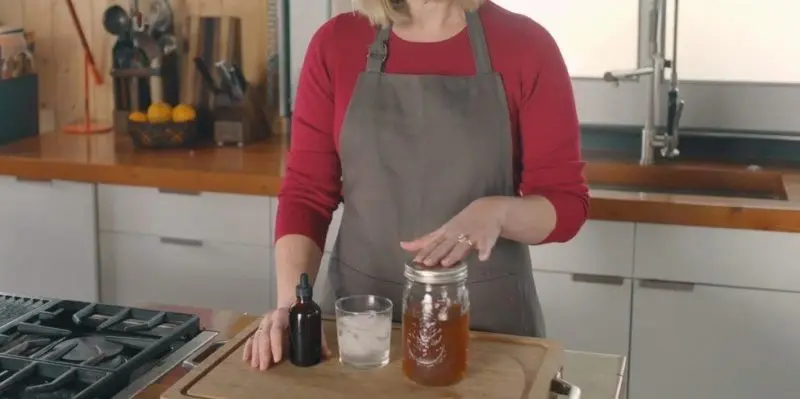
lemon bitter recipe
- 4 large lemons (zest)
- 1 st. l. fresh chopped ginger root
- 6 green cardamom pods
- ½ tsp crushed gentian root
- ½ tsp coriander seed
- 2 tbsp. l. lemongrass
- 1 Art. l. orange peel
- 350 ml of alcohol
- 350 ml of water
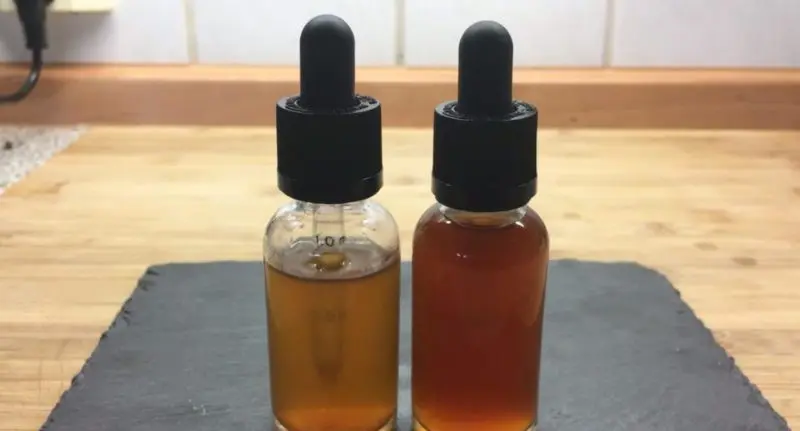
Finely chop the ginger root, remove the zest from the lemons, break the cardamom pods. Combine all ingredients except water in a tight resealable jar of a suitable volume. Insist in a dark warm place for 7 days, shake the contents of the jar daily. After a week, drain the aromatic alcohol through a sieve and leave to be stored in a tight closed container.
Pour the spices remaining in the jar, zest and ginger root into a small saucepan, add 350 ml of water and simmer for 10 minutes over low heat. Cool, leave in a tight closed jar for 7 days. Strain the water, filter and combine with alcohol. Keep the lemon bitter for 5-7 days, filter again and pour into small bottles of dark glass.
Bitter spicy/aromatic
- 2 tbsp. l. crushed gentian root
- 2 tbsp. l. chopped burdock root
- 1 large orange (zest)
- 2 cinnamon sticks
- 15 peas allspice
- 10 clove buds
- 3 star anise
- 45 g peeled ginger root
- 240 ml of water
- 240 g sugar (preferably brown)
- 350 ml alcohol (approx.)
Gentian root and burdock root are placed in a small container and poured with alcohol, completely covering the roots (about half of the alcohol specified in the recipe). Close the container tightly and leave in a dark, cool place for 3 weeks. Every day the contents must be mixed. In another container, place finely chopped ginger root, zest of one orange, cinnamon, pepper, cloves and other spices. Pour all this with the remaining alcohol and insist according to the scheme of bitter extract from gentian and burdock, that is, 3 weeks in a dark, cool place.
After 3 weeks, cook a simple syrup from sugar and water. Both extracts, bitter and spicy, drain through a sieve, drive through coffee filters or cotton wool. The resulting extracts and syrup should be mixed to taste. Recommended ratio: 4 parts fragrant extract to 1 part bitter, syrup is always added to taste. Store such a bitter after mixing should be in dark glass bottles in a cool, dry place. Shelf-life Unlimited.
Bitter spicy concentrated
This recipe is classified as a traditional “very bitter” bitter and is very similar in nature to Angostura and similar bitters. It is difficult to call the initial product of bitter maceration, it is rather a bitter essence, which is then used to make bitters, as well as an interesting bitter liquor. The weight is large, but dividing everything by 3-10 is not difficult.
- 85 g cardamom (grain)
- 140 g nutmeg (whole, grated)
- 225 g of coriander seeds
- 225 g cinnamon sticks (or bark)
- 225 g clove buds
- 225 g allspice peas
- 225 cumin
- 450 g cinchona bark
- 550 g angelica root
- 550 g galangal root (preferably galangal)
- 550 g gentian root
- 1 kg calamus root
- alcohol as needed
Grind all ingredients into powder (in a mortar, in a blender, etc.). Pour in alcohol so that it covers the spices and roots completely. Bitter should be soaked for 2 days, vigorously shaken several times every day. Strain, filter. To get “bitterness”, that is, a drinkable bitter, but it would be more correct to say liquor, mix 30 ml of prepared bitter essence with 1700 ml of 25% alcohol and 300 ml of simple syrup. To get a bitter for cocktails, mix 30-50 ml of bitter essence with two liters of vodka or alcohol 40-45%.
Italian Bitter Recipe
Similar to the previous one in terms of intensity of bitterness. The preparation procedure is the same as the proportions of further mixing. By ingredients, and, consequently, by organoleptic, bitter is very similar to Benedictine or Chartreuse (mostly green). The hitch is huge, so share it.
- 56 g rosemary sprigs
- 142 g thyme
- 142 g sage
- 142 g marjoram
- 198 g cloves
- Xnumx cinnamon
- 340 g orris root
- 340 g bitter wormwood
- 340 g of fennel
- 340 g calamus root
- 340 g of anise
- 453 g watch leaves
- 453 g angelica root
- 453 g lemon rind
- 567 g orange peel
The preparation of the bitter extract and the proportions of mixing bitter and liquor are described in the previous recipe.









